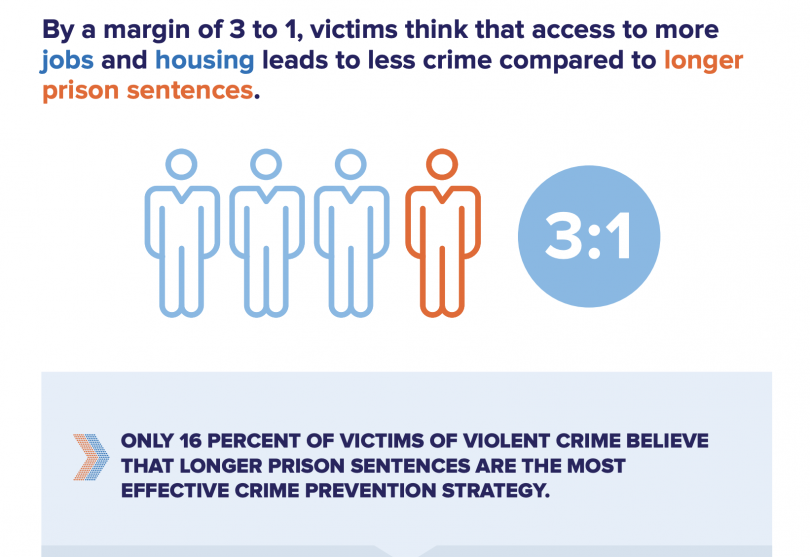A newly released national survey of crime survivors suggests that their needs and desires do not align with “tough on crime” laws and policies.
According to the survey conducted by the Alliance for Safety and Justice, what most survivors want are initiatives that interrupt the cycle of violence at the community level, not more carceral punishment.
Approximately one-third of the 1,200 random people the Alliance surveyed, said they had been victims of violent crime within the last 10 years.
The rates of victimization are higher among people of color, women, and people in lower-income households.
Forty-two percent of Black people and 40% of Latino respondents reported that they were victims of violence in the past 10 years, compared with 32% of white people. The rates of harm become more pronounced when sorting for income level.
Half of respondents who lived in households making less than $25,000 annually reported violent victimization within the last 10 years.
Sixty percent of Black people and 52% of Latino people who live in households with annual incomes less than $50,000 experienced victimization in the last decade, according to the survey.
The aftermath of victimization
Nearly half of victims surveyed said they experienced Post-traumatic Stress Disorder (PTSD), a rate that is 3.8 times higher than people who have not experienced violence. Victims of violence are also more than twice as likely to experience a life-threatening illness and nearly twice as likely to have a chronic illness or disability.
Such victims are also 3.6 times more likely to declare bankruptcy than non-victims.
“The prevalence of major hardship among survivors of violence is a strong indication that our current public safety system is failing,” the Alliance for Safety and Justice notes in its report. “The gap between the support victims of violence need to recover and what they attain leads to increased vulnerability to future victimization and worsened public safety.”
Victims prefer investment in communities over incarceration
When asked what they believed was the most effective strategy to prevent future crime, 48% of victims said more jobs and housing reduced crime, while 9% of respondents said cleaner neighborhoods had the greatest impact on reducing crime.
Sixteen percent of victims reported they believed increasing prison sentences was the most effective strategy against future crime, and 10% believed more arrests would be most effective at lowering crime rates.
Eleven percent of people said that when more crimes are solved, crime rates go down.
Sixty-eight percent of victims of violent crime also said they believed that mental health and addiction treatment and job training and placement were the most effective way to stop people from committing repeat crimes. Twenty-four percent said long sentences were the best deterrent.
Additionally, most respondents (57%) said they would favor candidates who supported shorter prison sentences, combined with using related savings to fund mental health and youth violence prevention. Thirty-seven percent said they would support candidates who favored long prison sentences and maintaining prison spending to keep people behind bars. Seven percent said they didn’t know.
Nearly three out of every five respondents said they preferred policies that prevented crime by strengthening communities rather than responding to crime by punishing people who commit crimes.
With regard to budget crises occurring in many cities and states, nearly two-thirds of the victims surveyed said mental health and addiction treatment, violence prevention and school programs, plus crisis assistance were the most important public safety measures to protect from budget cuts. Just under one-fourth of victims said police patrols were the most important public safety function to protect from budget cuts.
Victims also overwhelmingly prefer sentencing policies that allow judges to make sentencing decisions based on the individual circumstances of a case, the victim, and the defendant. Seventy-two percent said judges should have discretion, while 21% said they preferred uniform sentence lengths for categories of crime.
“The vision for safety victims of violence propose stands in stark contrast to current practices,” concluded the Alliance for Safety and Justice. “Listening to the experiences and preferences of violent crime victims can — and should — guide policymakers toward new solutions that can address the dual crisis of a lack of safety and mass incarceration. Their voices and leadership can solve both problems.”


The polls don’t lie. The Left’s favorite District Attorney lost by a landslide here in Lost Angeles. Your skewed narrative surely doesn’t match the voice of victims who overwhelmingly ousted extreme leftist ideologies on 5 Nov. Your über progressive voice continues to fall on deaf ears, while more and more law abiding citizens realize the flaws in the “turn the other cheek” mindset.
No, crime survivors want accountability. And punishment of the criminals. Also, the only people who want less jail time are the demographics (black, Hispanic, etc.) who commit the most crimes LOL.